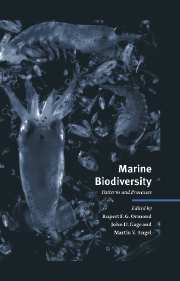Book contents
- Frontmatter
- Contents
- List of contributors
- Foreword: The value of diversity
- 1 Marine biodiversity in its global context
- 2 Gradients in marine biodiversity
- 3 Pelagic biodiversity
- 4 Biological diversity in oceanic macrozooplankton: More than counting species
- 5 Large-scale patterns of species diversity in the deep-sea benthos
- 6 Diversity, latitude and time: Patterns in the shallow sea
- 7 High benthic species diversity in deep-sea sediments: The importance of hydrodynamics
- 8 Diversity and structure of tropical Indo-Pacific benthic communities: Relation to regimes of nutrient input
- 9 Why are coral reef communities so diverse?
- 10 The biodiversity of coral reef fishes
- 11 The historical component of marine taxonomic diversity gradients
- 12 Population genetics and demography of marine species
- 13 Discovering unrecognised diversity among marine molluscs
- 14 Ecosystem function at low biodiversity – the Baltic example
- 15 Land–seascape diversity of the USA East Coast coastal zone with particular reference to estuaries
- 16 The development of mariculture and its implications for biodiversity
- 17 Protecting marine biodiversity and integrated coastal zone management
- 18 Conserving biodiversity in North-East Atlantic marine ecosystems
- Author index
- Species index
- Subject index
2 - Gradients in marine biodiversity
Published online by Cambridge University Press: 04 August 2010
- Frontmatter
- Contents
- List of contributors
- Foreword: The value of diversity
- 1 Marine biodiversity in its global context
- 2 Gradients in marine biodiversity
- 3 Pelagic biodiversity
- 4 Biological diversity in oceanic macrozooplankton: More than counting species
- 5 Large-scale patterns of species diversity in the deep-sea benthos
- 6 Diversity, latitude and time: Patterns in the shallow sea
- 7 High benthic species diversity in deep-sea sediments: The importance of hydrodynamics
- 8 Diversity and structure of tropical Indo-Pacific benthic communities: Relation to regimes of nutrient input
- 9 Why are coral reef communities so diverse?
- 10 The biodiversity of coral reef fishes
- 11 The historical component of marine taxonomic diversity gradients
- 12 Population genetics and demography of marine species
- 13 Discovering unrecognised diversity among marine molluscs
- 14 Ecosystem function at low biodiversity – the Baltic example
- 15 Land–seascape diversity of the USA East Coast coastal zone with particular reference to estuaries
- 16 The development of mariculture and its implications for biodiversity
- 17 Protecting marine biodiversity and integrated coastal zone management
- 18 Conserving biodiversity in North-East Atlantic marine ecosystems
- Author index
- Species index
- Subject index
Summary
I found to my great surprise at this enormous depth – not, as might be presumed according to Forbes' hypothesis – a poor and oppressed Fauna, but on the contrary a richly developed and varied animal life; so that my father (Michael Sars) was able in 1869 to increase the catalogue of the forms of animal life observed at the depths of 200–300 fathoms, by the addition of not less than 335 species (in all 427) of which nearly all were taken at one locality, namely the fishing place Skraaven in Lofoten.
We may therefore, … presume that the Cretaceous formation is continued undisturbed at this present day in the depths of the Ocean … while the Fauna at smaller depths, and especially the shore-Fauna, would in relatively short time, by reason of telluric and physical revolutions, be forced entirely to change its character.
G.O. SARS 1872.Abstract
It has been claimed that just as on land the marine domain shows a cline of increasing diversity from poles to tropics. Recent data however, suggest that this may only hold for the northern hemisphere. On land there is a gradient of decreasing diversity with altitude. A marine counterpart has been suggested, but here with an increase in diversity with increasing depth. The original data on which this gradient was postulated are examined critically in the light of new data.
- Type
- Chapter
- Information
- Marine BiodiversityPatterns and Processes, pp. 18 - 34Publisher: Cambridge University PressPrint publication year: 1997
- 10
- Cited by



